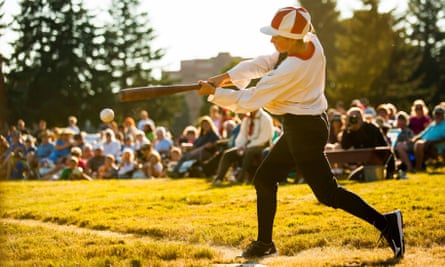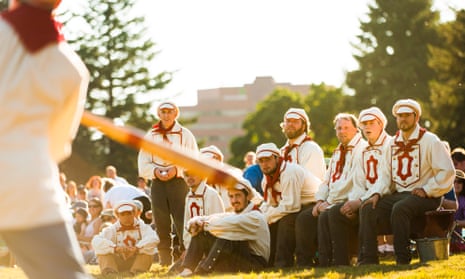As the rain began to fall, Brigid Day looked around the field of play, pausing for a moment. It was only a drizzle, she figured, but it wouldn’t take much more than a light coating to lend a certain slickness to the playing surface. After all, Day mused, this was baseball.
Except it wasn’t baseball per se. Not as she had come to know it.
This was base ball, the original game, from which today’s modern version evolved. Bare bones. Minus the hoopla. A barren field of play, not quite familiar to the game she’d been raised to love: essentially a piece of pastureland. The couture, ditto: heavy, baggy uniforms topped off with antiquated soft caps. Peculiar nomenclature: “Huzzah!” and references to the “willow,” the “dish” and the “striker.” (Translated: Hooray! The bat, the home plate and the batter.)
In the early days, no gloves were used by fielders. Pitchers, then known as bowlers, as in cricket, threw underhand. Batters were considered out when balls were caught after the first bounce. Base ball. Before sportswriters could contract the two words into one. Playing like they did in 1864, when the civil war was still raging. The very roots.
“I fell in love instantly,” says the 44-year-old Day, a librarian from Brentwood, Tennessee, and a lifelong softball player and fan of the Chicago Cubs, of her morphing into a ballist, the contemporary term for a base ball player. “It was such an interesting twist to a game that I have played recreationally my whole life. I remember that first day when it started to drizzle. The new players all kind of looked around because we were used to baseball, where once the rain comes, the game ends. But we were playing base ball,” adds Day, also known by the nickname “Ginger,” another example of the vintage game’s faithfulness to tradition.

Day plays for the Travellers Vintage Base Ball Club of Brentwood, one of about 500 teams spread across the United States and Canada. The vintage game, as it has become known, has grown at quite a clip since first formally organizing in 1996 from just 13 clubs. It has its own national body, the Vintage Base Ball Association, which has the aim of preserving formative versions of the sport and creating greater awareness of baseball’s origins.
It’s an intriguing slice of Americana. A blend of historical re-enactment and competitive endeavor, the game could be said to occupy something of a fraught intersection between where baseball was and where it is now. In different states, the rules vary. In Tennessee, they play by those from 1864. In North Texas, by rules from 1860. In the San Francisco Bay area, by rules from the 1880s. These varying eras track an evolving game in tandem with a changing society. Aspects of that include the role of African Americans in baseball, and where women fit into the game in the early days.
“People will ask me: ‘Should she be playing on this team?’ Or: ‘Your team looks fairly diverse. Is this what it was actually like?’ So we will answer saying there were women’s leagues,” explains Danielle Brissette, a historian involved with the Farmers Branch Mustangs team in North Texas.
“They generally wouldn’t have played the men unless there was some kind of fundraiser. It’s a way of talking about the past without lecturing.” Or how in her area, there wouldn’t have been much racial integration in teams or leagues. Which gives her a jumping off point to talk about the strength of the old Texas Negro leagues. So too the specter of wider societal upheaval: “As a historian, it opens up a lense for me to talk about all the other things going on in the 1860s,” she goes on, “like the civil war, or women’s suffrage, or the passing of the 13th, 14th, 15th amendments. Some of those huge political movements you can look at through baseball.”
That history might help explain the make-up of those who tend to gravitate toward it. Day is emblematic of one major quadrant of your typical ballist: a lover of the game. But the sport also counts hipsters in search of something off-mainstream, and conservative types attracted by a sense of nostalgia, a period when gentlemanly conduct pervaded the game. Even those who crave a scintilla of officialdom.
“You get the hipster, Avett Brothers-type guy or girl. You get people who just love history. You get people who just want to be the judge, which is what they called the umpire, out there with their top hat, their vest and their bow tie,” says Jeff Campbell, a 55-year-old who works in historic preservation and who grew up playing base ball on pastureland in rural Georgia, dodging cow manure as he went. “There’s people who are out there for the history re-enactment part. People there for the fun of playing the game. Then there’s also people who really want to study the history of the game and how it changed through the years.” Campbell is behind a new team in North Texas called the Plano Cats, who take their cues from a pre-Spanish-American war team named the Plano Nine. He considers himself a portmanteau of the different types of characters attracted to vintage base ball. “I think there’s a real romance to it, it’s fun to put on the old uniforms, and it’s just kind of snowballed from there.”

Sean McNally is a 26-year-old radio personality who plays on the Lightfoot VBBC of Chattanooga, Tennessee. He recently got the chance to speak to little leaguers about the history of a game that not only dwarves them but also the origins of the sport they’re learning. A time, he says, before the age of huge contracts and giant stadiums to which one day they might aspire. “But the game came from guys playing for the love of the game in a field that may have had a hill in right field or a tree in center. The grass wasn’t cut. Bats and balls were turned and stitched by hand.”
A useful grounding perhaps. But also inherent in those words might be a hint of baseball’s achilles heel: The idea that the game is too prone to look back as it struggles for relevance amid a modern tableau of sporting offerings.
“I think the simplicity of the game is attractive,” says Trapper Haskins, president of the Tennessee Association of Vintage Base Ball. “There were only 40 rules in 1864, no bullpens or designated hitters, no advanced metrics. Hell, they didn’t even have gloves. Vintage base ball is a reprieve from a very hectic culture.”
Back in North Texas, historian Brissette, new to organized sport, appreciates the ability to present a chapter of the past in a way that portrays the people of the time as something other than chaste. “I think we spend a lot of time doing things like doing the laundry and talking about how people grew their food and about how hard life was,” explains the 28-year-old museum educator. “And we don’t spend a lot of time talking about what was enjoyable about living 150 years ago. What did people do for fun? We have this image that everyone’s just sitting around a fire reading Longfellow and quoting Shakespeare and a Bible at each other. It sounds fun for some people but for most of us it doesn’t sound like an ideal way to spend one’s entire life.”
For all that, baseball close to its original form was still something more austere. In their re-creations, vintage teams can strive for a level of historical accuracy that can drill all the way down to the buttons on team shirts. Ballists might get a ticking off for wearing shades, for instance. Or they may be asked to take a sharpie pen to branded emblems on their cleats. To boot, those early customs such as the ability to get an out following a catch after the first bounce: heckling fans spurred a rule change that dictated only balls caught on the fly could be counted as outs, explains Campbell of the Plano Cats. There went the barehanded catch. The baseball glove shortly became ubiquitous.
The living history aspect of the game is essentially figurative at heart. But not always. At one event, the omnipotence of formal baseball’s civil war origins bore an actual living face directly related to that tumultuous past in the form of Walter Lynn Bates, or “Hawkeye”. The Corryton, Tennessee, resident of South Carolinian extraction joined the Knoxville Holstons team late in their 2014 campaign in part as a means of placing a capstone over the heart attack and subsequent bypass surgery he’d endured several years before. A civil war and baseball buff, participating in the vintage version was ideal on a number of fronts. Then an unusual thing happened, lending a neat narrative twist to his introduction to the sport.
“At the 2014 TAOVBB tournament, which is held each September at Carnton Plantation in Franklin, Tennessee, our captain Adam Alfrey asked me to throw out the first pitch,” the 52-year-old recalls. “This was a moment of personal and historical meaning: My ancestor, Lorenzo Dow Bates, was a private in the Third Tennessee Volunteer Infantry, USA. He fought at the Battle of Franklin and I was throwing out the first pitch 150 years later on the same battlefield.”

Comments (…)
Sign in or create your Guardian account to join the discussion